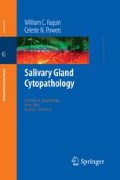Salivary gland fine-needle aspiration (FNA) represents one of the most challenging areas of cytopathology. This is due in part to the wide range of lesions, both reactive and neoplastic, that can be encountered in the more than 500 salivary glands present in the human body. In fact, histologically (and cytologically), salivary gland tumors have been described as one of the most heterogeneous groups of human tumors; over 40 subtypes of neoplasms have been reported. An additional challenge for salivary gland FNA is the significant cytomorphologic diversity and overlap between many benign and malignant salivary gland tumors. In general, ancillary marker studies are of limited value in solving this problem because many salivary gland tumors have a similar composition of epithelial and myoepithelial cells. With all of these hurdles to overcome, it is quite impressive that salivary gland FNA emerges as an accurate and effective tool for diagnosing this complex group of lesions. Currently, FNA has gained wide acceptance as a first-line procedure in the evaluation of a salivary gland mass. In this book, we use an algorithmic approach (see Chapter 3) to guide you through the principles of salivary gland cytology, pointing out pitfalls, limitations, and differential diagnoses along the way, to allow you to use salivary gland FNA accurately and effectively.
FNA was first described in 1847 by Kun, and later, in the 1930’s, it was reintroduced and promoted by Martin and Ellis. While FNA remained popular in Europe and particularly in Scandinavian countries, it is only in the past 30 years that it has seen a resurgence in popularity in the United States. Currently, FNA is used extensively throughout the country for the assessment of both palpable and deep-seated lesions in most anatomic sites. FNA is performed manually by cytopathologists, clinicians, and surgeons for the assessment of palpable masses, and it is performed under ultrasound or CT-guidance for nonpalpable deep-seated or cystic lesions. It is considered standard of care to use FNA as an initial step in the evaluation of any thyroid nodule, and more and more it is being used to provide a preoperative diagnosis and thereby guide the clinical management of patients presenting with a salivary gland mass.
Access this chapter
Tax calculation will be finalised at checkout
Purchases are for personal use only
Preview
Unable to display preview. Download preview PDF.
References
Barnes L, Eveson JW, Reichart P, Sidransky D. World Health Organization Classification of Tumours: Pathology and Genetics of Head and Neck Tumours. Lyon: IARC Press, 2005.
Engzell V, Esposti DL, Rubio C, Sigurdson A, Zajicek J. Investigation of tumor spread in connection with aspiration biopsy. Acta Radiol Ther 1971;10:385–398.
Frable WJ. Thin-needle aspiration biopsy. Am J Clin Pathol 1976;65:168–181.
Li S, Baloch ZW, Tomaszewski JE, LiVolsi VA. Worrisome histologic alterations following fine-needle aspiration of benign parotid lesions. Arch Pathol Lab Med 2000;124:87–91.
Hughes JH, Volk EE, Wilbur DC. Pitfalls in salivary gland fine-needl aspiration cytology: Lessons from the College of American Pathologists Interlaboratory Comparison Program in Nongynecologic Cytology. Arch Pathol Lab Med 2005;129:26–31.
Kakagia D, Alexiadis G, Kiziridou A, Lambropoulou M. Brooke-Spiegler syndrome with parotid gland involvement. Eur J Dermatol 2004;14:139–141.
Major salivary glands (parotid, submandibular, and sublingual). In: American Joint Committee on Cancer: AJCC Cancer Staging Manual. 6th ed. New York: Springer, 2002; 53–58.
Mukunyadzi P. Review of fine-needle aspiration cytology of salivary gland neoplasms, with emphasis on differential diagnosis. Am J Clin Pathol 2002;118S:S100–115.
Muskat JE, Wynder EL. A case/control study of risk factors for major salivary gland cancer. Otolaryngol Head Neck Surg 1998;118:195–198.
National Cancer Institute website for salivary gland cancer: http://www.cancer.gov/cancertopics/pdq/treatment/salivarygland/healthprofessional
Powers CN. Complications of fine needle aspiration biopsy: the reality behind the Myths. In: Schmidt WA (ed), Cytopathology, Vol.1, ASCP Reviews in Pathology. Chicago:ASCP Press, 1996;69–96.
Rimm DL, Stastny JF, Rimm EB, Ayer S, Frable WJ. Comparison of the costs of fine-needle aspiration and open surgical biopsy as methods for obtaining a pathologic diagnosis. Cancer Cytopathol 1997;81:51–56.
Seethaia RR, LiVolsi VA, Baloch ZW. Relative accuracy of fine-needle aspiration and frozen section in the diagnosis of lesions of the parotid gland. Head & Neck 2005;27:217–223.
Author information
Authors and Affiliations
Editor information
Editors and Affiliations
Rights and permissions
Copyright information
© 2008 Springer Science+Business Media, LLC
About this chapter
Cite this chapter
Faquin, W.C., Powers, C.N. (2008). Introduction to FNA and Salivary Gland Neoplasia. In: Faquin, W.C., Powers, C.N. (eds) Salivary Gland Cytopathology. Essentials in Cytopathology Series, vol 5. Springer, Boston, MA. https://doi.org/10.1007/978-0-387-76623-2_1
Download citation
DOI: https://doi.org/10.1007/978-0-387-76623-2_1
Publisher Name: Springer, Boston, MA
Print ISBN: 978-0-387-76622-5
Online ISBN: 978-0-387-76623-2
eBook Packages: MedicineMedicine (R0)

